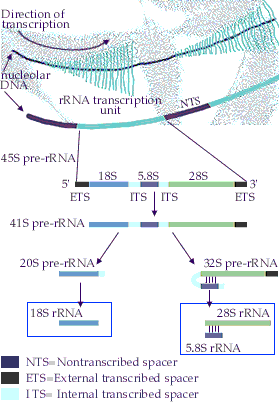|
|
rRNA Synthesis and Processing The genes coding for rRNA (except 5S rRNA) are
located in the nucleolar part of the nucleus. The
rRNA genes are highly repetitious and mammalian cells
contain 100 to 2000 copies of the rRNA genes per
cell. The genes are organised in transcription units
separated by non-transcribed spacers. Each
transcription unit contains sequences coding for 18S,
5.8S and 28S rRNA.
The primary transcript is processed into the mature 18S, 5.8S and 28S rRNAs. The processing involves exo- and endo-nucleolytic cleavages guided by snoRNA (small nucleolar RNAs) in complex with proteins. The mature rRNAs contain modified nucleotides which are added after transcription by a snoRNA-dependent mechanism. 5S ribosomal RNA is transcribed by RNA polymerase III in the nucleoplasm. Each eukaryotic cell contains a high number of copies of the 5S coding gene (up to 20 000 copies per cell). 5S rRNA contains overlapping binding sites for two different proteins, ribosomal protein L5 and transcription factor TFIIIA. The mutual exclusive binding of these two proteins to 5S rRNA is important for coordinating the expression of 5S rRNA to the production of the other rRNAs. |
